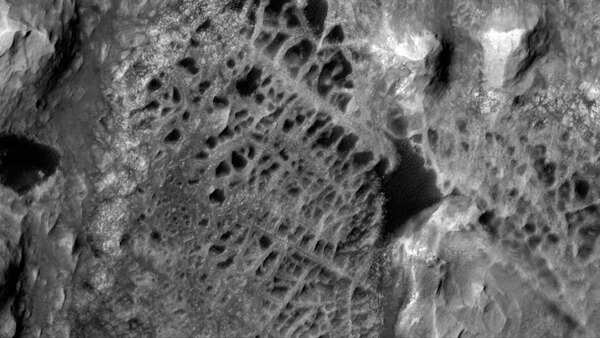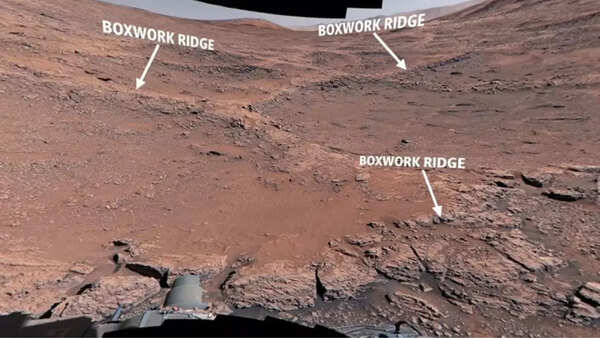NASA's Curiosity rover has transmitted the first close-up images of unusual, spiderweb-like rock formations on the Martian surface, offering tantalizing new clues about the Red Planet's watery past.
These peculiar zig-zagging structures, dubbed "boxwork," were discovered on the slopes of Mount Sharp within Gale Crater, where Curiosity has been diligently exploring since 2012. The intricate, mineral-rich ridges are believed to have formed from ancient groundwater activity, creating web-like patterns when viewed from above. Scientists are hopeful that these formations may hold crucial information regarding Mars' potential to have supported microbial life in the distant past.

Despite their intriguing nickname, these spiderweb-like structures are not the work of Martian insects. Instead, they are geological formations known as boxwork. This pattern of intersecting mineral ridges forms when groundwater seeps through cracks in the rock, leaving behind mineral deposits. Over eons, wind erosion gradually removes the surrounding, softer rock, revealing the hardened, web-like framework beneath.
While boxwork formations have been observed from orbit previously, this marks the first instance of their close examination on the Martian surface. Curiosity reached this specific site in early June 2025, after traversing Mount Sharp for several months. NASA unveiled the images and a 3D interactive video of the formations on June 23, emphasizing their unique structure and the unexplained nature of their location as a high-priority scientific target.

Analysis of the surrounding rocks has revealed veins of calcium sulfate, a salty mineral residue commonly left behind by groundwater. These findings strongly suggest that the area was once abundant in liquid water, and the underground environment might have been warm and salty – potentially conducive to microbial life, akin to certain regions on early Earth.
It's important not to confuse the newly imaged boxwork formations with the "spiders on Mars," which are dark, radial patterns caused by carbon dioxide ice erupting from beneath the surface. Unlike these seasonal features, boxwork is a permanent, mineral-based formation resulting from geological processes rather than atmospheric ones.
Scientists speculate that these formations could play a pivotal role in resolving the ongoing debate about whether Mars once harbored life. The mineral composition, the protected underground conditions, and the evidence of flowing water collectively suggest an environment that could have sustained microbial organisms. According to Curiosity mission scientist Kirsten Siebach, "Early Earth microbes could have survived in a similar environment."
Curiosity will continue its investigation of this particular patch of boxwork on Mount Sharp, collecting samples through drilling and conducting thorough chemical analyses. Researchers anticipate that these unique structures will not only shed more light on Mars' climatic history but also provide valuable guidance for future missions aimed at detecting signs of life beneath the Martian surface.
Newer articles
 The 'Good Cop, Bad Cop' Parenting Strategy: Does It Do More Harm Than Good?
The 'Good Cop, Bad Cop' Parenting Strategy: Does It Do More Harm Than Good?
 5 Natural Ways to Strengthen Your Heart and Reduce Disease Risk
5 Natural Ways to Strengthen Your Heart and Reduce Disease Risk
 Broadside: Broad Slams India's Team Choices After Headingley Test, Calls for Edgbaston XI Changes
Broadside: Broad Slams India's Team Choices After Headingley Test, Calls for Edgbaston XI Changes
 Wimbledon Serves Up India: Tennis Giant Courts Cricket-Crazy Nation for Growth
Wimbledon Serves Up India: Tennis Giant Courts Cricket-Crazy Nation for Growth
 England's Ben Duckett: The New Virender Sehwag? Former Coach Draws Bold Comparison
England's Ben Duckett: The New Virender Sehwag? Former Coach Draws Bold Comparison
 Archer Set for England Return? Broad and Buttler Advocate for Pacer's Second Test Inclusion
Archer Set for England Return? Broad and Buttler Advocate for Pacer's Second Test Inclusion
 Ashada Gupt Navratri 2025: Unveiling Dates, Timings, and Esoteric Significance
Ashada Gupt Navratri 2025: Unveiling Dates, Timings, and Esoteric Significance
 Suryakumar Yadav's Sports Hernia Surgery: What It Is, Who's at Risk, and Path to Recovery
Suryakumar Yadav's Sports Hernia Surgery: What It Is, Who's at Risk, and Path to Recovery
 The Evil Eye: Protective Charm or Portal to Darkness? Exploring the Symbol's Dual Interpretations
The Evil Eye: Protective Charm or Portal to Darkness? Exploring the Symbol's Dual Interpretations
 Jaiswal Eyes Gavaskar's 49-Year Record: India's Opener Nears Milestone 2,000 Test Runs in Edgbaston Clash
Jaiswal Eyes Gavaskar's 49-Year Record: India's Opener Nears Milestone 2,000 Test Runs in Edgbaston Clash